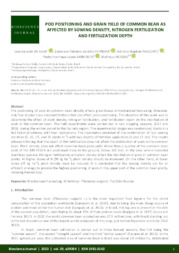Pod positioning and grain yield of common bean as affected by sowing density, nitrogen fertilization and fertilization depth.
Pod positioning and grain yield of common bean as affected by sowing density, nitrogen fertilization and fertilization depth.
Autoria: SILVA, J. G. da; FERREIRA, E. P. de B.; NASCENTE, A. S.; SARMENTO, P. H. L.; MESSIAS, M.
Resumo: The positioning of pods in common bean directly affects grain losses in mechanized harvesting. However, only few studies have assessed facttors that can affect pods positioning. The objective of this work was to determine the effect of plant density, nitrogen fertilization, and fertilization depth on the distribution of pods of the common bean. The field experiments were carried out in two cropping seasons, 2017 and 2018, during the winter period in the Cerrado region. The experimental design was randomized blocks in a 4x2 factorial scheme, with four replications. The treatments consisted of the combination of four sowing densities (5, 10, 15, and 20 plants m-1) with two depths of fertilizer application (6 and 12 cm). The results allowed inferring that the depth of the fertilization does not affect the distribution of pods in the common bean. Plant density does not affect common bean grain yield. More than a quarter of the common bean pods of the BRS FC104 are positioned close to the ground, below 100 mm, in the area where harvester machines operate. Nitrogen fertilization and plant density affect the distribution of pods in common bean plants. At higher doses of N (90 kg ha-1), plant density should be increased. On the other hand, at lower doses (45 kg ha-1), plant density must be reduced. It is concluded that the sowing density can be an efficient strategy to provide the highest positioning of pods in the upper part of the common bean plants, reducing harvest loss.
Ano de publicação: 2023
Tipo de publicação: Artigo de periódico
Unidade: Embrapa Arroz e Feijão
Observações
1 - Por padrão são exibidas publicações dos últimos 20 anos. Para encontrar publicações mais antigas, configure o filtro ano de publicação, colocando o ano a partir do qual você deseja encontrar publicações. O filtro está na coluna da esquerda na busca acima.
2 - Para ler algumas publicações da Embrapa (apenas as que estão em formato ePub), é necessário ter, no celular ou computador, um desses softwares gratuitos. Sistemas Android: Google Play Livros; IOS: iBooks; Windows e Linux: software Calibre.
Acesse outras publicações
Acesse a Base de Dados da Pesquisa Agropecuária (BDPA) para consultar o acervo completo das bibliotecas da Embrapa.

